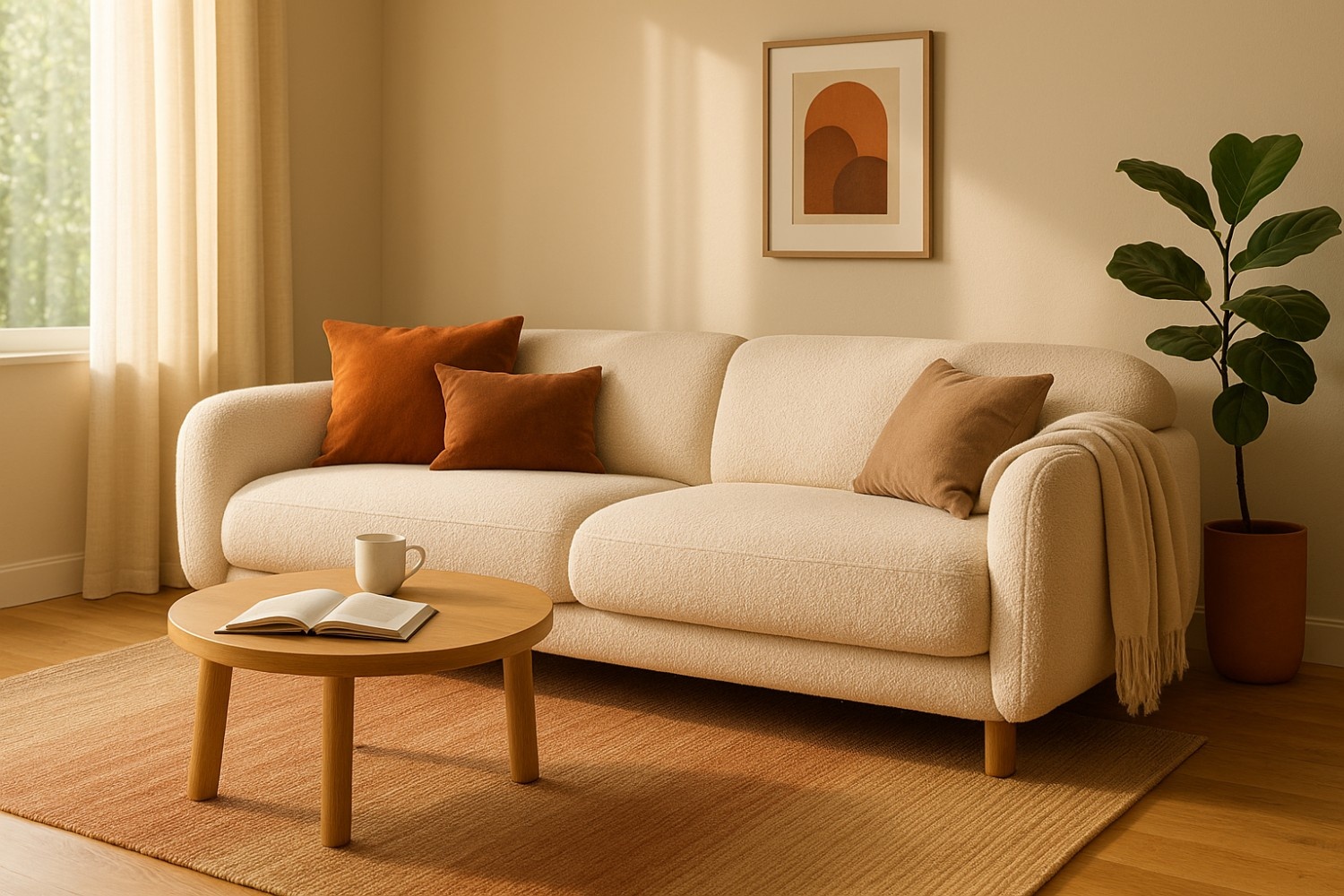How to Choose the Perfect Sofa for Your Living Room

Strong 8k brings an ultra-HD IPTV experience to your living room and your pocket.
Choosing the perfect sofa for your living room is both a practical and aesthetic decision. A sofa isn't just another piece of furniture—it's the heart of your living space. It's where family gathers, guests are entertained, and evenings are spent relaxing. A good sofa blends comfort, durability, and design, complementing your interior while supporting your lifestyle.
This comprehensive guide walks you through everything you need to consider to select the ideal sofa—from size and shape to upholstery, colour, and placement—so you can make an informed choice that brings style and comfort to your home.
1. Start with the Room’s Measurements
Before falling in love with any design, measure your living room. Take note of:
- Room length and width
- Doorway and hallway dimensions
- Ceiling height
- Window and radiator positions
These measurements help determine the maximum sofa size you can comfortably fit in the room. A piece that's too large may dominate the space, while a sofa that's too small can feel lost and underwhelming.
Use masking tape or furniture templates to map out the sofa's potential footprint. Consider how much walking space you'd like around the piece, typically leaving at least 18–24 inches for pathways.
2. Consider the Sofa’s Function
What role will the sofa play in your living room? Here are a few use-case examples:
- Primary lounging area: Opt for deep cushions, wide armrests, or even a sectional.
- Entertaining guests: A stylish yet comfortable two- or three-seater may suffice.
- Multi-functional use: Sleeper sofas or ones with storage can be ideal for small spaces or multifunctional rooms.
A sofa must fit your daily life. If you have kids or pets, think about durability and ease of cleaning. For movie buffs, a reclining sofa or L-shaped sectional can offer the ultimate comfort.
3. Choose the Right Sofa Size and Shape
Once your room measurements and usage are determined, the next step is choosing the size and shape.
Common Sofa Sizes:
- Loveseat (2-seater): Perfect for smaller rooms or as a secondary seating option.
- Standard Sofa (3-seater): The go-to size for most living rooms.
- Sectional or Corner Sofas: Ideal for large families or open-plan living.
Popular Sofa Shapes:
- L-Shaped: Great for corners or defining spaces in open-plan layouts.
- U-Shaped: Offers a cocooning effect, ideal for large families or entertainment zones.
- Chaise Lounge: Provides a relaxed, luxurious feel and works well against a wall or window.
If you're unsure, browse a curated sofa collection to compare layouts and see which one resonates with your needs.
4. Select the Perfect Upholstery Material
Sofa upholstery has a significant impact on the look, feel, and longevity of the piece. Common materials include:
Fabric Sofas:
- Pros: Soft, comfortable, a wide range of colours and patterns.
- Cons: Can stain easily unless treated with stain-resistant coatings.
Leather Sofas:
- Pros: Durable, classic appearance, easy to wipe clean.
- Cons: Can be expensive; may feel cold in winter and hot in summer.
Velvet Sofas:
- Pros: Luxurious texture and rich appearance.
- Cons: Requires regular maintenance and isn't ideal for homes with pets.
Microfiber:
- Pros: Extremely durable and stain-resistant.
- Cons: Less breathable than natural fabrics.
When browsing options, the Best furniture store in UK often provides material samples, allowing you to touch and feel the texture before committing.
5. Pick a Sofa Colour That Matches Your Aesthetic
Colour plays a critical role in the visual impact of your sofa. Consider these factors:
- Room Size: Light colours like beige, grey, or cream can make a small room appear larger.
- Natural Light: Rooms with ample light can handle darker colours without feeling closed-in.
- Decor Style: Match or complement your current colour palette. Bold colours make a statement, while neutral shades offer versatility.
Don't forget to consider trends. Earthy tones and muted greens are currently very popular, offering both modern appeal and timeless warmth.
6. Frame and Cushion Quality: Don’t Compromise
A good-looking sofa is great—but if it isn’t built to last, it’s not worth the investment.
Sofa Frame
- Hardwood (like beech or oak): Durable and sturdy.
- Softwood (like pine): Less expensive but more prone to warping over time.
- Metal Frames: Offer durability but can lack warmth.
Cushion Fillings:
- Foam: Firm and supportive but may flatten over time.
- Feather: Luxuriously soft but requires fluffing and maintenance.
- Hybrid (foam and feather): Offers a balanced mix of comfort and support.
Always look for reviews or test the sofa in-store when possible.
7. Match the Style with Your Interior Design
Your sofa should not only fit the space but also enhance your room's visual style. Consider these popular styles:
Contemporary: Clean lines, minimalistic, often with metal or wooden legs.
Traditional: Rolled arms, tufted cushions, and ornate detailing.
Mid-Century Modern: Low profile, wooden legs, and sleek designs.
Scandinavian: Neutral tones, soft textures, and functional simplicity.
Whether you're leaning toward timeless elegance or cutting-edge design, browsing a reputable sofa collection can help narrow down your style preferences.
8. Think About Maintenance and Durability
Your lifestyle heavily influences what sofa type is most appropriate:
Families with kids: Look for stain-resistant fabric, washable cushion covers, and solid construction.
Pet owners: Avoid velvet and opt for microfiber or leather, which are easier to clean and less likely to trap fur.
Allergy sufferers: Choose hypoallergenic fabrics and make sure the cushions are easy to remove for cleaning.
Removable covers or modular designs also allow you to refresh or upgrade parts of your sofa without replacing the entire unit.
9. Test Before You Buy
Even if you're planning to purchase online, it's worth visiting a showroom to test a few models. When you sit, consider:
- Does your back feel supported?
- Is the depth comfortable for your height?
- Do your feet touch the floor?
- Is the cushion density right for your preference?
If you can't test the sofa in person, ensure there’s a good return policy and read customer reviews to gauge real-life comfort and durability.
10. Set a Realistic Budget
Sofas come in a wide price range—from affordable fast-furniture models to designer pieces. Define your budget before you shop, and balance your priorities:
- Under £500: May suit students or temporary housing.
- £500–£1,500: Offers a range of good-quality sofas with various styles and materials.
- £1,500+: Expect premium craftsmanship, designer aesthetics, and long-term durability.
Don’t forget to factor in delivery costs, extended warranties, or assembly services.
11. Choose a Trustworthy Retailer
The final step in your sofa-buying journey is finding a store you trust. Look for retailers that offer:
- Clear return policies
- Warranty coverage
- Responsive customer service
- In-home delivery and assembly options
Explore the Best furniture store in UK to compare styles, prices, and customer experiences. Reputable stores often have online tools for customization, room planning, and even AR visualization to see how the sofa will look in your space.
Conclusion: Your Sofa, Your Statement
Choosing the perfect sofa is more than a checklist—it’s a journey to finding the right fit for your lifestyle and living room. A well-chosen sofa adds warmth, functionality, and style to your home for years to come.
By considering size, function, upholstery, colour, style, and budget, you can make a smart investment. And by exploring a curated sofa collection or shopping at the Best furniture store in UK, you’ll be equipped with options that cater to both your practical needs and your design dreams.
Note: IndiBlogHub features both user-submitted and editorial content. We do not verify third-party contributions. Read our Disclaimer and Privacy Policyfor details.







